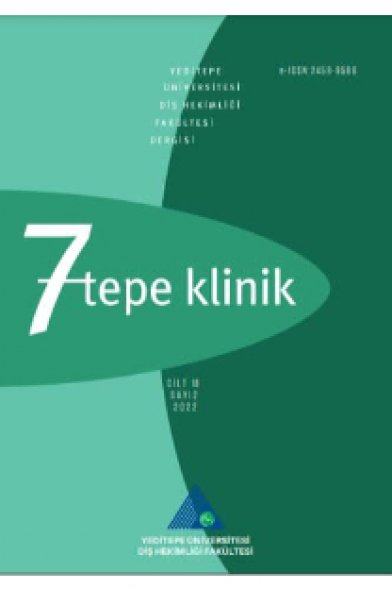Partial edentulism and treatment options
Parsiyel dişsizlik ve tedavi seçenekleri
___
- Hessari H, Vehkalahti MM, Eghbal MJ, Murtomaa H. Tooth loss and prosthodontic rehabilitation among 35- to year-old Iranians. J Oral Rehabil 2008; 35: 245-251.
- Zitzmann NU, Hagmann E, Weiger R. What is the preva- lence of various types of prosthetic dental restorations in Europe? Clin Oral Implants Res 2007; 18 Suppl 3: 20-33.
- Charyeva OO, Altynbekov KD, Nysanova BZ. Kennedy classification and treatment options: a study of partially edentulous patients being treated in a specialized pros- thetic clinic. J Prosthodont 2012; 21: 177-180.
- Dhingra K. Oral rehabilitation considerations for par- tially edentulous periodontal patients. J Prosthodont ; 21: 494-513.
- Budtz-Jörgensen E. Restoration of the partially eden- tulous mouth--a comparison of overdentures, removable partial dentures, fixed partial dentures and implant treat- ment. J Dent 1996; 24: 237-244.
- Curtis DA, Curtis TA, Wagnild GW, Finzen FC. Inci- dence of various classes of removable partial dentures. J Prosthet Dent 1992; 67: 664-667.
- Niarchou AP, Ntala PC, Karamanoli EP, Polyzois GL, Frangou MJ. Partial edentulism and removable partial denture design in a dental school population: a survey in Greece. Gerodontology 2011; 28: 177-183.
- Henderson D, McGivney GP, Castleberry DJ. McCrack- en's removable partial prosthodontics. 7th ed. CV Mosby. St. Louis, Toronto, Princeton 1985, pp: 21-126.
- Keyf F. Frequency of the Various Classes of Removable Partial Dentures and Selection of Major Connectors and Direct/Indirect Retainers. Turk J Med Sci 2001; 31: 445
- The Glossary of Prosthodontic Terms. 7th ed. CV Mos- by. 2005; 94, pp: 47.
- AL-Dwairi ZN. Partial edentulism and removable den- ture construction: a frequency study in Jordanians. Eur J Prosthodont Restor Dent 2006; 14: 13-17.
- Ehikhamenor EE, Oboro HO, Onuora OI, et al. Types of removable prostheses requested by patients who were presented to the University of Benin Teaching Hospital Dental Clinic. J Dent Oral Hyg 2010; 2: 15-18.
- Sadig WM, Idowu AT. Removable partial denture de- sign: a study of a selected population in Saudi Arabia. J Contemp Dent Pract 2002; 15: 40-53.
- Miller EL. Systems for classifying partially dentulous arches. J Prosthet Dent 1970; 24: 25-40.
- McCaul LK, Jenkins WM, Kay EJ. The reasons for the extraction of various tooth types in Scotland: a 15-year follow up. J Dent 2001; 29: 401-407.
- Brudvik JS. Implants and removable partial dentures. In: Brudvick JS, ed. Advanced removable partial dentures. Chicago: Quitnessence Publishing Co; 1999; p: 153-159.
- Jepson NJ, Thomason JM, Steele JG. The influence of denture design on patient acceptance of partial den- tures. Br Dent J 1995; 178: 296-300.
- Vermeulen AH, Keltjens HM, van't Hof MA, Kayser AF. Ten-year evaluation of removable partial dentures: surviv- al rates based on retreatment, not wearing and replace- ment. J Prosthet Dent 1996; 76: 267-272.
- Wetherell JD, Smales RJ. Partial denture failures: a long-term clinical survey. J Dent 1980; 8: 333-340.
- Wostmann B, Budtz-Jorgensen E, Jepson N, Mushimoto E, Palmqvist S, Sofou A et al. Indications for removable partial dentures: a literature review. Int J Prost- hodont 2005; 18: 139-145.
- de Freitas RF, de Carvalho Dias K, da Fonte Porto Car- reiro A, Barbosa GA, Ferreira MA. Mandibular implant-sup- ported removable partial denture with distal extension: a systematic review. J Oral Rehabil 2012; 39: 791-798.
- Quirynen M, Naert I, van Steenberghe D, Dekeyser C, Callens A. Periodontal aspects of osseointegrated fix- tures supporting a partial bridge. An up to 6-years retro- spective study. J Clin Periodontol 1992; 19: 118-126.
- Zarb GA, Schmitt A. The longitudinal clinical effec- tiveness of osseointegrated dental implants in posterior partially edentulous patients. Int J Prosthodont 1993; 6: 196.
- Heydecke G, Boudrias P, Awad MA, De Albuquerque RF, Lund JP, Feine JS. Within-subject comparisons of maxillary fixed and removable implant prostheses: Pa- tient satisfaction and choice of prosthesis. Clin Oral Im- plants Res 2003; 14: 125-130.
- Ozkurt Z, Kazazoğlu E. Treatment modalities of sin- gle-tooth missing in a Turkish subpopulation: Implant, fixed partial denture or no restoration. J Dent Sci 2010; : 183-188.
- Budtz-Jİrgensen E, Isidor F, Karring T. Cantilevered fixed partial dentures in a geriatric population: prelimi- nary report. J Prosthet Dent 1985; 54: 467-473.
- Douglass CW, Watson AJ. Future needs for fixed and removable partial dentures in the United States. J Pros- thet Dent 2002; 87: 9-14.
- Dikbas I, Ozkurt Z, Kazazoglu E. Predoctoral prostho- dontic curriculum on removable partial dentures: survey in Turkish dental faculties. J Dent Educ 2013; 77: 85-92.
- ISSN: 2458-9586
- Yayın Aralığı: Yılda 3 Sayı
- Başlangıç: 2005
- Yayıncı: Yeditepe Üniversitesi Rektörlüğü
Diş renkleşmeleri ve beyazlatma tedavileri
Zümrüt Ceren ÖZDUMAN, Çiğdem ÇELİK
Prosthetic restoration types of dental implants
Zeynep KAYAHAN ÖZKURT, Ender KAZAZOĞLU
Evaluation of different instrumentation systems for apical extrusion of debris
RECAİ ZAN, HÜSEYİN SİNAN TOPÇUOĞLU, İHSAN HUBBEZOĞLU, JALE TANALP, Meric KAZANDAĞ KARAPINAR
Yaşar Meriç TUNCA, DURSUN ALİ ŞİRİN
Multidisciplinary treatment for a young patient with severe bone loss from a trauma: A case report
Berkay Tolga SÜER, CUMHUR KORKMAZ
Partial edentulism and treatment options
Zeynep KAYAHAN ÖZKURT, Ceyda TOMRUK ÖZÇAKIR, Ender KAZAZOĞLU
A methodological study on improving a new orthodontic face mask
NURHAT ÖZKALAYCI, MEHMET YETMEZ
Endodontik-periodontal lezyonlu mandibular moların kombine tedavisi: Bir olgu sunumu
Fatma KANMAZ, Turan Emre KUZU, RECAİ ZAN, DEMET ALTUNBAŞ
Classification and current treatment options of endo-perio lesions
